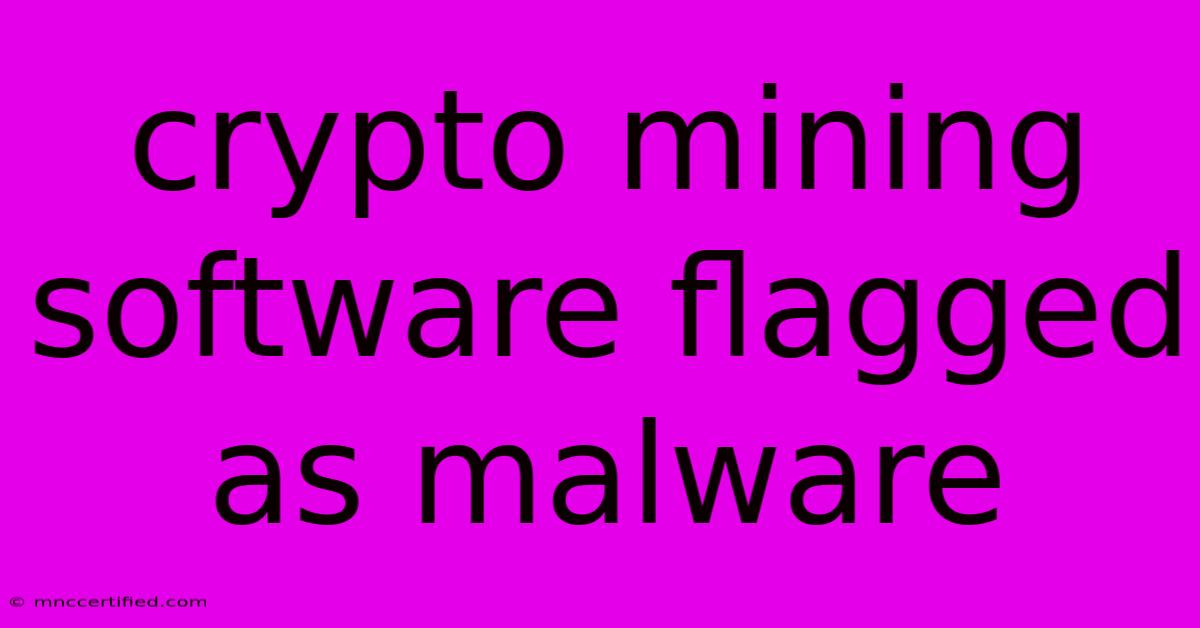Crypto Mining Software Flagged As Malware

Table of Contents
Crypto Mining Software Flagged as Malware: Why and What to Do
The cryptocurrency mining boom has attracted both legitimate businesses and malicious actors. While some software aims to help users mine cryptocurrency, others use deceptive tactics and exploit vulnerabilities to steal resources and profit. This can result in crypto mining software being flagged as malware by antivirus programs, leaving users confused and concerned.
Understanding the Issue: Why Is My Crypto Mining Software Flagged as Malware?
There are several reasons why crypto mining software might be flagged as malware:
- Hidden Malware: Some crypto mining software contains hidden malware that can steal sensitive data, compromise your system, or even hijack your mining resources for the attacker's gain. This malicious code can be bundled with the mining software, making it difficult to detect unless you have a robust antivirus program.
- Excessive Resource Consumption: Legitimate crypto mining software requires significant processing power, memory, and energy. If the software uses resources excessively without your consent, it can be misidentified as malware, especially if it negatively affects your computer's performance.
- Unverified Software: Downloading crypto mining software from untrusted sources increases the risk of installing malware. Always download software from official websites or reputable app stores to minimize the risk of encountering malicious programs.
- Outdated Antivirus Software: Antivirus programs might not be able to detect new forms of malware, especially those associated with crypto mining. Ensure your antivirus is up-to-date and has the latest definitions to effectively identify potential threats.
Identifying Legitimate Crypto Mining Software:
Here are some key factors to consider when evaluating crypto mining software:
- Reputation and Reviews: Research the software developer and check online reviews from other users. Look for reputable companies with a track record of providing safe and efficient mining solutions.
- Open Source and Transparency: Choose software with open-source code, which allows for greater transparency and scrutiny. This makes it easier to identify potential malicious code.
- Resource Management: Check the software's resource consumption settings. Ensure you can control the amount of processing power and energy used to avoid excessive strain on your system.
- Security Features: Look for software with strong security features, such as password protection and encryption to protect your data and prevent unauthorized access.
What to Do If Your Crypto Mining Software is Flagged as Malware:
- Don't Panic: Don't immediately uninstall or ignore the warning. First, consider the source of the flag. Is it from a reputable antivirus program or an unfamiliar software?
- Investigate the Software: Verify the software's legitimacy by checking its official website, forums, and reviews.
- Check Your Antivirus Settings: Ensure your antivirus is up-to-date and re-scan your computer with the latest definitions. This might help identify false positives.
- Monitor Your System: Pay close attention to your computer's performance after installing the software. Look for any unusual behavior, such as excessive CPU usage, slowdowns, or unexpected software installations.
- Consider a Second Opinion: If you are still unsure, consult a trusted tech expert or cybersecurity professional for a second opinion. They can help determine if the software is legitimate or malicious.
Conclusion:
Crypto mining software can be a legitimate tool for earning cryptocurrency, but it's essential to exercise caution and stay informed about potential risks. Be vigilant when downloading software, research developers, and choose reputable options with strong security features. By following these steps, you can minimize the risk of encountering malicious software and ensure a safe and efficient mining experience.

Thank you for visiting our website wich cover about Crypto Mining Software Flagged As Malware. We hope the information provided has been useful to you. Feel free to contact us if you have any questions or need further assistance. See you next time and dont miss to bookmark.
Featured Posts
-
Medical Insurance For Wisdom Teeth Removal
Nov 07, 2024
-
George Gandy Insurance Carlsbad New Mexico
Nov 07, 2024
-
Life And Health Insurance License Oklahoma
Nov 07, 2024
-
Do You Get A Bond For Probation Violation
Nov 07, 2024
-
Trump Victory Blocks Walzs Vp Bid
Nov 07, 2024